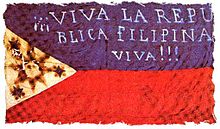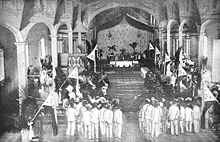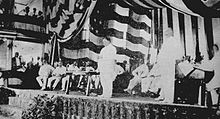Philippine Revolution
Revolutionary sentiments arose in 1872 after three Filipino priests, Mariano Gómez, José Burgos, and Jacinto Zamora, known as Gomburza, were accused of sedition by colonial authorities and executed. This would inspire the Propaganda Movement in Spain, organized by Marcelo H. del Pilar, José Rizal, Graciano López Jaena, and Mariano Ponce, that clamored for adequate representation to the Spanish Cortes and later for independence. José Rizal, the most celebrated intellectual and radical ilustrado of the era, wrote the novels "Noli Me Tángere", and "El filibusterismo", which greatly inspired the movement for independence. The Katipunan, a secret society whose primary purpose was that of overthrowing Spanish rule in the Philippines, was founded by Andrés Bonifacio who became its Supremo (leader).
The Philippine Revolution began in 1896. Rizal was wrongly implicated in the outbreak of the revolution and executed for treason in 1896. The Katipunan in Cavite split into two groups, Magdiwang, led by Mariano Álvarez (a relative of Bonifacio's by marriage), and Magdalo, led by Emilio Aguinaldo. Leadership conflicts between Bonifacio and Aguinaldo culminated in the execution or assassination of the former by the latter's soldiers. Aguinaldo agreed to a truce with the Pact of Biak-na-Bato and Aguinaldo and his fellow revolutionaries were exiled to Hong Kong. Not all the revolutionary generals complied with the agreement. One, General Francisco Makabulos, established a Central Executive Committee to serve as the interim government until a more suitable one was created. Armed conflicts resumed, this time coming from almost every province in Spanish-governed Philippines.
In 1898, as conflicts continued in the Philippines, the USS Maine, having been sent to Cuba because of U.S. concerns for the safety of its citizens during an ongoing Cuban revolution, exploded and sank in Havana harbor. This event precipitated the Spanish–American War.[97] After Commodore George Dewey defeated the Spanish squadron at Manila, a German
squadron arrived in Manila and engaged in maneuvers which Dewey, seeing
this as obstruction of his blockade, offered war—after which the
Germans backed down. The German Emperor expected an American defeat, with Spain left in a
sufficiently weak position for the revolutionaries to capture
Manila—leaving the Philippines ripe for German picking.
The U.S. invited Aguinaldo to return to the Philippines in the hope
he would rally Filipinos against the Spanish colonial government.
Aguinaldo arrived on May 19, 1898, via transport provided by Dewey. By
the time U.S. land forces had arrived, the Filipinos had taken control
of the entire island of Luzon, except for the walled city of Intramuros. On June 12, 1898, Aguinaldo declared the independence of the Philippines in Kawit, Cavite, establishing the First Philippine Republic under Asia's first democratic constitution.
In the Battle of Manila,
the United States captured the city from the Spanish. This battle
marked an end of Filipino-American collaboration, as Filipino forces
were prevented from entering the captured city of Manila, an action
deeply resented by the Filipinos. Spain and the United States sent commissioners to Paris to draw up the terms of the Treaty of Paris which ended the Spanish–American War. The Filipino representative, Felipe Agoncillo, was excluded from sessions as the revolutionary government was not recognized by the family of nations. Although there was substantial domestic opposition, the United States decided to annex the Philippines. In addition to Guam and Puerto Rico, Spain was forced in the negotiations to hand over the Philippines to the U.S. in exchange for US$20,000,000.00.
U.S. President McKinley justified the annexation of the Philippines by
saying that it was "a gift from the gods" and that since "they were
unfit for self-government, ... there was nothing left for us to do but
to take them all, and to educate the Filipinos, and uplift and civilize
and Christianize them",
in spite of the Philippines having been already Christianized by the
Spanish over the course of several centuries. The first Philippine
Republic resisted the U.S. occupation, resulting in the Philippine–American War (1899–1913).
American rule (1898–1946)
Filipinos initially saw their relationship with the United States as that of two nations joined in a common struggle against Spain. However, the United States later distanced itself from the interests of the Filipino insurgents. Emilio Aguinaldo was unhappy that the United States would not commit to paper a statement of support for Philippine independence. Relations deteriorated and tensions heightened as it became clear that the Americans were in the islands to stay.
Philippine–American War
Hostilities broke out on February 4, 1899, after two American privates on patrol killed three Filipino soldiers in San Juan, a Manila suburb. This incident sparked the Philippine–American War, which would cost far more money and took far more lives than the Spanish–American War. Some 126,000 American soldiers would be committed to the conflict; 4,234 Americans died, as did 12,000–20,000 Philippine Republican Army soldiers who were part of a nationwide guerrilla movement of indeterminate numbers.
The general population, caught between Americans and rebels, suffered
significantly. At least 200,000 Filipino civilians lost their lives as
an indirect result of the war mostly as a result of the cholera epidemic at the war's end that took between 150,000 and 200,000 lives. Atrocities were committed by both sides.
The poorly equipped Filipino troops were easily overpowered by
American troops in open combat, but they were formidable opponents in
guerrilla warfare. Malolos,
the revolutionary capital, was captured on March 31, 1899. Aguinaldo
and his government escaped, however, establishing a new capital at San Isidro, Nueva Ecija. On June 5, 1899, Antonio Luna, Aguinaldo's most capable military commander, was killed by Aguinaldo's guards in an apparent assassination while visiting Cabanatuan, Nueva Ecija to meet with Aguinaldo. With his best commander dead and his troops suffering continued defeats as American forces pushed into northern Luzon,
Aguinaldo dissolved the regular army on November 13 and ordered the
establishment of decentralized guerrilla commands in each of several
military zones. Another key general, Gregorio del Pilar, was killed on December 2, 1899 in the Battle of Tirad Pass—a rear guard action to delay the Americans while Aguinaldo made good his escape through the mountains.
Aguinaldo was captured at Palanan, Isabela
on March 23, 1901 and was brought to Manila. Convinced of the futility
of further resistance, he swore allegiance to the United States and
issued a proclamation calling on his compatriots to lay down their arms,
officially bringing an end to the war.
However, sporadic insurgent resistance continued in various parts of
the Philippines, especially in the Muslim south, until 1913.
In 1900, President McKinley sent the Taft Commission, to the Philippines, with a mandate to legislate laws and re-engineer the political system. On July 1, 1901, William Howard Taft, the head of the commission, was inaugurated as Civil Governor, with limited executive powers. The authority of the Military Governor was continued in those areas where the insurrection persisted. The Taft Commission passed laws to set up the fundamentals of the new
government, including a judicial system, civil service, and local
government. A Philippine Constabulary was organized to deal with the remnants of the insurgent movement and gradually assume the responsibilities of the United States Army.
The Tagalog, Negros and Zamboanga Cantonal Republics
During the First Philippine Republic, three other insurgent republics were briefly formed: the Tagalog Republic in Luzon, under Macario Sakay, the Negros Republic in the Visayas under Aniceto Lacson, and the Republic of Zamboanga in Mindanao under Mariano Arquiza. Despite resistance from these three republics ignored by Aguinaldo who included them in his gift to the USA, all three were eventually dissolved and the Philippines was ruled as a singular insular territory.Insular Government (1901–1935)
The Philippine Organic Act was the basic law for the Insular Government, so called because civil administration was under the authority of the U.S. Bureau of Insular Affairs. This government saw its mission as one of tutelage, preparing the Philippines for eventual independence. On July 4, 1902 the office of military governor was abolished and full executive power passed from Adna Chaffee, the last military governor, to Taft, who became the first U.S. governor-general of the Philippines.In socio-economic terms, the Philippines made solid progress in this period. Foreign trade had amounted to 62 million pesos in 1895, 13% of which was with the United States. By 1920, it had increased to 601 million pesos, 66% of which was with the United States. A health care system was established which, by 1930, reduced the mortality rate from all causes, including various tropical diseases, to a level similar to that of the United States itself. The practices of slavery, piracy and headhunting were suppressed but not entirely extinguished.
A new educational system was established with English as the medium of instruction, eventually becoming a lingua franca of the Islands. The 1920s saw alternating periods of cooperation and confrontation with American governors-general, depending on how intent the incumbent was on exercising his powers vis-à-vis the Philippine legislature. Members to the elected legislature lobbied for immediate and complete independence from the United States. Several independence missions were sent to Washington, D.C. A civil service was formed and was gradually taken over by Filipinos, who had effectively gained control by 1918.
Philippine politics during the American territorial era was dominated by the Nacionalista Party, which was founded in 1907. Although the party's platform called for "immediate independence", their policy toward the Americans was highly accommodating. Within the political establishment, the call for independence was spearheaded by Manuel L. Quezon, who served continuously as Senate president from 1916 until 1935.
World War I gave the Philippines the opportunity to pledge assistance to the US war effort. This took the form of an offer to supply a division of troops, as well as providing funding for the construction of two warships. A locally recruited national guard was created and significant numbers of Filipinos volunteered for service in the US Navy and army.
Frank Murphy was the last Governor-General of the Philippines (1933–35), and the first U.S. High Commissioner of the Philippines (1935–36). The change in form was more than symbolic: it was intended as a manifestation of the transition to independence.
Commonwealth
The Great Depression in the early thirties hastened the progress of the Philippines towards independence. In the United States it was mainly the sugar industry and labor unions that had a stake in loosening the U.S. ties to the Philippines since they could not compete with the Philippine cheap sugar (and other commodities) which could freely enter the U.S. market. Therefore, they agitated in favor of granting independence to the Philippines so that its cheap products and labor could be shut out of the United States. In 1933, the United States Congress passed the Hare–Hawes–Cutting Act as a Philippine Independence Act over President Herbert Hoover's veto. Though the bill had been drafted with the aid of a commission from the Philippines, it was opposed by Philippine Senate President Manuel L. Quezon, partially because of provisions leaving the United States in control of naval bases. Under his influence, the Philippine legislature rejected the bill. The following year, a revised act known as the Tydings–McDuffie Act was finally passed. The act provided for the establishment of the Commonwealth of the Philippines with a ten-year period of peaceful transitions to full independence. The commonwealth would have its own constitution and be self-governing, though foreign policy would be the responsibility of the United States, and certain legislation required approval of the United States president. The Act stipulated that the date of independence would be on the July 4 following the tenth anniversary of the establishment of the Commonwealth.
A Constitutional Convention was convened in Manila on July 30, 1934. On February 8, 1935, the 1935 Constitution of the Republic of the Philippines was approved by the convention by a vote of 177 to 1. The constitution was approved by President Franklin D. Roosevelt on March 23, 1935 and ratified by popular vote on May 14, 1935.
On September 17, 1935, presidential elections were held. Candidates included former president Emilio Aguinaldo, the Iglesia Filipina Independiente leader Gregorio Aglipay, and others. Manuel L. Quezon and Sergio Osmeña of the Nacionalista Party were proclaimed the winners, winning the seats of president and vice-president, respectively.
The Commonwealth Government was inaugurated on the morning of November 15, 1935, in ceremonies held on the steps of the Legislative Building in Manila. The event was attended by a crowd of around 300,000 people. Under the Tydings–McDuffie Act this meant that the date of full independence for the Philippines was set for July 4, 1946, a timetable which was followed after the passage of almost eleven very eventful years.
World War II and Japanese occupation
Military
Japan launched a surprise attack on the Clark Air Base in Pampanga on the morning of December 8, 1941, just ten hours after the attack on Pearl Harbor. Aerial bombardment was followed by landings of ground troops on Luzon. The defending Philippine and United States troops were under the command of General Douglas MacArthur. Under the pressure of superior numbers, the defending forces withdrew to the Bataan Peninsula and to the island of Corregidor at the entrance to Manila Bay.On January 2, 1942, General MacArthur declared the capital city, Manila, an open city to prevent its destruction. The Philippine defense continued until the final surrender of United States-Philippine forces on the Bataan Peninsula in April 1942 and on Corregidor in May of the same year. Most of the 80,000 prisoners of war captured by the Japanese at Bataan were forced to undertake the infamous Bataan Death March to a prison camp 105 kilometers to the north. About 10,000 Filipinos and 1,200 Americans died before reaching their destination.
President Quezon and Osmeña had accompanied the troops to Corregidor
and later left for the United States, where they set up a government in
exile. MacArthur was ordered to Australia, where he started to plan for a return to the Philippines.
The Japanese military authorities immediately began organizing a new government structure in the Philippines and established the Philippine Executive Commission. They initially organized a Council of State, through which they directed civil affairs until October 1943, when they declared the Philippines an independent republic. The Japanese-sponsored republic headed by President José P. Laurel proved to be unpopular.
The Japanese military authorities immediately began organizing a new government structure in the Philippines and established the Philippine Executive Commission. They initially organized a Council of State, through which they directed civil affairs until October 1943, when they declared the Philippines an independent republic. The Japanese-sponsored republic headed by President José P. Laurel proved to be unpopular.
Japanese occupation of the Philippines was opposed by large-scale underground and guerrilla activity. The Philippine Army, as well as remnants of the U.S. Army Forces Far East, continued to fight the Japanese in a guerrilla war and was considered an auxiliary unit of the United States Army. Their effectiveness was such that by the end of the war, Japan controlled only twelve of the forty-eight provinces. One element of resistance in the Central Luzon area was furnished by the Hukbalahap, which armed some 30,000 people and extended their control over much of Luzon.



No comments:
Post a Comment